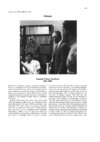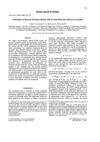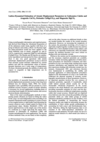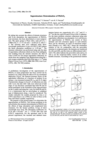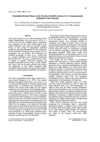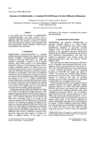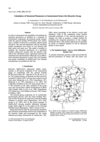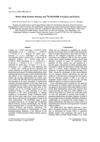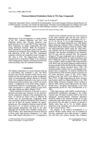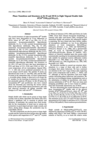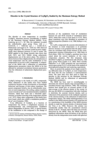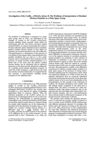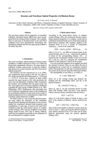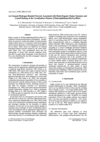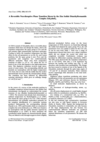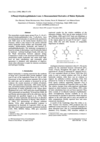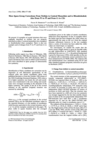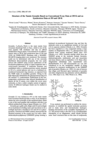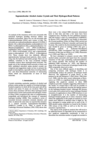issue contents
October 1998 issue

Cover illustration: Space filling representation of the hydrated anionic framework formed by trimesic acid around piles of cobalticinium cations in crystalline [(C5H5)2Co][(H3TMA)(H2TMA)].2H2O. Graphics (picture or drawing) obtained using SCHAKAL by E. Keller, University of Freiburg, Germany. Courtesy of D. Braga and F. Grepioni
obituaries
Free 

research papers
A model is described for allowing for internal torsional motion and its correlation with overall molecular motion in crystals, in the quadratic approximation. Examples are given and limitations discussed.
Atomic displacement parameters, vibrational frequencies and estimates of specific heat and entropy have been evaluated for carbonates of the calcite group using lattice dynamics and empirical transferable force fields.
The superstructure of PbZrO3 is determined by using 0.35 Å synchrotron radiation with only the data of superlattice reflections. It is found that Zr atoms show the antiphase-type displacements along the z axis.
The crystal structures of five new cristobalite-related sodium aluminosilicates with four different structure types have been refined by the Rietveld method from X-ray powder diffraction data. Good starting models for two of the structures were obtained from analogous phases, while starting models for the other two with previously unreported structure types were derived using a modulation wave approach.
The crystal structure of a commensurately modulated cubic cristobalite-related sodium aluminosilicate structure has been modelled using a modulation wave approach and the model tested against X-ray powder diffraction data using the Rietveld method. The tetrahedral framework model and Na/vacancy ordering were derived from consideration of the dominant modulation waves and a pseudo-extinction condition observed in the diffraction data. This is the first cubic cristobalite-related superstructure phase reported and provides insight into the enigmatic high-temperature structure of cristobalite.
A combined refinement of neutron powder diffraction and gallium K-edge EXAFS has permitted the complete structure elucidation of Ca8(Ga2SiO6)4(OH)8
The structural parameters of kieserite family members are predicted on the basis of the size of both cation and anion. The agreement between calculated and refined parameters is good.
The crystal structures and NMR spectra of K2Si2O5 and Li2Si2O5 have been determined and the effect of moisture on mixed alkali aqueous and silicate systems described.
At high pressure the anion arrangement in TiF3 and FeF3 is deformed similar to a sphere-packing deformation of the type 8/3/c2, while repulsive interactions between the cations result in a certain extent of octahedron strain.
A new framework is proposed for the quantitative description of perovskite structures. It can be used to predict starting models for structural refinements from the chemical composition.
The structure and charge density for Na2Ni(CN)4.3H2O at 295 and 30 K, with hydrogen parameters at 30 K, have been determined from neutron data. Spin density was determined by polarized neutrons at 1.6 K.
A phase transition from a very simple R-3m to an equally simple twinned R-3 structure is observed in most cases, in which trigonal symmetry of the MIII site is preserved. Crystal properties are correlated with MI and X ionic radii and MIII-N distances.
Like other A2BX4-type compounds, Cs2HgCl4 exhibits large-amplitude anharmonic displacements at room temperature (soft mode). The Maximum Entropy Method is used to determine the atomic displacements corresponding to the disorder at room temperature.
Crystal structures of five crystals in the Cs2xRb2-2xTi2O2As2O8 series are reported and discussed. The low-temperature behaviour of two members (x = 0.71 and x = 0.86) is reported and analysed together with the room-temperature pseudo-symmetry of all the structures.
The problems of refinements of structures in a polar space group, such as Pna21, are illustrated using the example of Cs2xRb2-2xTi2O2As2O8. Using a combination of simulated data sets and different refinement strategies, distinction between pseudo-symmetic `ghosting' and real atomic occupancy of inversion-related sites is made with the conclusion that some structures in the series are truly disordered.
The crystal structure and non-linear optical properties of β-barium borate are theoretically investigated, from the chemical bond viewpoint.
The title compound is a polymer with metal-organic chains stacked along the a axis of the crystal. The structure is stabilized by an extensive hydrogen-bonded network comprising tridymite-like O8 cages.
CCDC reference: 131734
ZnI2(dmf)2, zinc diiodide bis(dimethylformamide), shows a reversible non-disruptive phase change at 228 K. The space group changes from C2/c to P21/n, with two new conformationally different molecules arising at low temperature from rotation of one of the dmf ligands through angles of either +25 or -43°. Application of differential scanning calorimetry gives ΔH = 1.44 kJ mol−1.
The crystal structure of C14H10N2O2 has been determined at 293 K and the hydrogen-bonding pattern compared with those in the related crystals maleic hydrazide (two polymorphs), dichloromaleic hydrazide and luminol. The measured dimensions of monoclinic maleic hydrazide have been compared with those obtained from an extensive series of high-level molecular orbital calculations.
CCDC reference: 131737
Download citation


Download citation


Symmetry reported as lower than correct has been detected in (most of) the crystals discussed by using reduced cells and Niggli matrices.
 CCDC references
CCDC referencesThe 75 non-H atom structure of geraniin heptahydrate, a tannin with antidiarrheic activity, was solved using a 20-atom fragment in an initial vector search with DIRDIF. Low-temperature synchrotron data allowed identification of almost all the H atoms, so that ~30 different hydrogen bonds can be studied.
Five p-phenylenediamine–alcohol cocrystal structures and the graph-set analysis of the hydrogen-bonding patterns in published alcohol–amine structures are discussed.


 journal menu
journal menu












